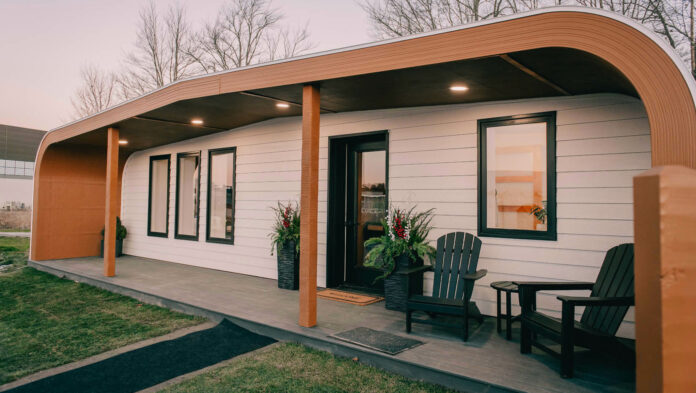The house is the result of a public-private collaboration, supported by DOE’s Advanced Materials and Manufacturing Technologies Office
The University of Maine is making headlines ever since it inaugurates BioHome3D, a 3D printed house made entirely with bio-based materials. Described as the first of its kind, the house is fully recyclable and highly insulated with 100% wood insulation and customizable R-values.
Construction waste was nearly eliminated due to the precision of the printing process. “With its innovative BioHome3D, UMaine’s Advanced Structures and Composites Center is thinking creatively about how we can tackle our housing shortage, strengthen our forest products industry, and deliver people a safe place to live so they can contribute to our economy. While there is still more to be done, today’s development is a positive step forward — one that I was proud to support through my Maine Jobs & Recovery Plan and my budget. I extend my congratulations and thanks to the University of Maine and its partners, and I look forward to continuing to tackle these problems with innovative solutions”, said Gov. Janet Mills.
In addition to the already known advantages of construction 3D printing (speed of construction accelerated, time saving and automated manufacturing), it should be noted that these materials support the revitalization of local forest product industries and are more resilient to global supply chain disruptions and labor shortages.
The prototype is currently sited on a foundation outside ASCC, equipped with sensors for thermal, environmental and structural monitoring to test how BioHome3D performs through a Maine winter. Researchers expect to use the data collected to improve future designs. BioHome3D was printed in four modules, then moved to the site and assembled in half a day. Electricity was running within two hours with only one electrician needed on site.
“Many technologies are being developed to 3D print homes, but unlike BioHome3D, most are printed using concrete. However, only the concrete walls are printed on top of a conventionally cast concrete foundation. Traditional wood framing or wood trusses are used to complete the roof,” said Dr. Habib Dagher, ASCC executive director. “Unlike the existing technologies, the entire BioHome3D was printed, including the floors, walls and roof. The biomaterials used are 100% recyclable, so our great-grandchildren can fully recycle BioHome3D.”
The successful print of BioHome3D builds on the ASCC’s demonstrated excellence in advanced manufacturing, design and modeling. The prototype was printed on the world’s largest polymer 3D printer, which, in 2019, produced the world’s largest 3D-printed boat.
Remember, you can post job opportunities in the AM Industry on 3D ADEPT Media or look for a job via our job board. Make sure to follow us on our social networks and subscribe to our weekly newsletter : Facebook, Twitter, LinkedIn & Instagram ! If you want to be featured in the next issue of our digital magazine or if you hear a story that needs to be heard, make sure you send it to contact@3dadept.com


